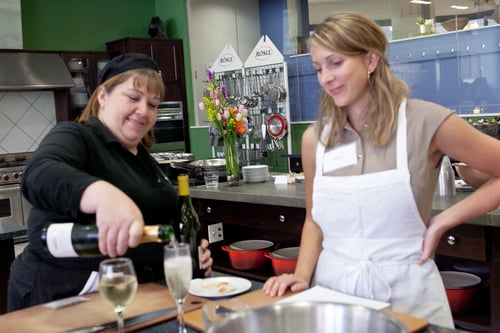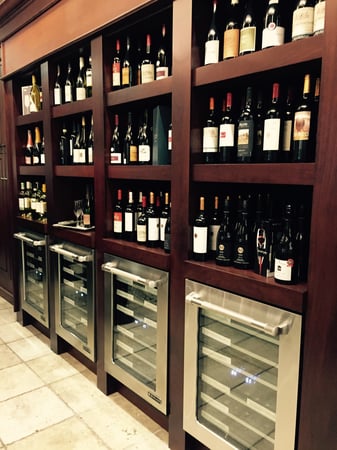
Bubbles should not only be reserved for New Year's Eve or special occasions. I tend to enjoy the crisp, fizzy deliciousness of sparkling wine year-round, with and without the addition of orange juice depending on time of day. But even if you are a fan of sparkling wine, you may not really know the difference between Champagne and Prosecco.

Champagne
Champagne is a sparkling wine produced by inducing the in-bottle secondary fermentation of the wine to effect carbonation. It’s a geographical thing and has to do with terroir, or where the grapes are grown. The Champagne region is special in terms of soil and climate — you can’t duplicate that somewhere else. Pinot noir, pinot meunier and chardonnay are the primary grapes, and carbonation is from méthode champenoise — a secondary fermentation directly in the bottle. Tradition is a big part of it, and Champagne is protected and regulated by the EU.
The term "Champagne" is used to refer to wine produced exclusively within the Champagne region of France, from which it takes its name. Other good sparkling wines are made around the world, but true Champagne is made in only one place. When I was 21, I spent time traveling through France and had the pleasure of visiting Champagne, and well as Reims – another popular destination for champagne tasting and toasting. I lugged home 3 bottles of Champagne for my family! My mom is still keeping the bottle I got her to pop when I get engaged. Jeez… no pressure!
Prosecco
While I tend to drink Champagne on special occasions, I find myself drinking Prosecco more often simply because I like the taste, it makes a perfect mimosa, and we sell a label I love year round at The Chopping Block. It’s our house bubbly, Adami Prosecco and it’s VERY reasonably priced.
In Italy, Prosecco is enjoyed as a wine for every occasion. Outside Italy, it is most often drunk as an aperitif, much like Champagne. Like other sparkling wines, Prosecco is served chilled. Unlike Champagne, Prosecco does not ferment in the bottle and grows stale with time. It should be drunk as young as possible and preferably within three years of its vintage, although high-quality Prosecco can be aged for up to seven years.
Compared to other sparkling wines, Prosecco is low in alcohol, about 11 to 12 percent by volume. The flavor of Prosecco has been described as intensely aromatic and crisp, bringing to mind yellow apple, pear, white peach and apricot. Unlike Champagne, appreciated for its rich taste and complex secondary aromas most Prosecco variants have intense primary aromas and are meant to taste fresh, light and comparatively simple.
Most commonly Prosecco is served unmixed, but it also appears in several mixed drinks. It was the original main ingredient in the Bellini cocktail and in the Spritz cocktail, and it can also replace Champagne in other cocktails such as the Mimosa. With vodka and lemon sorbet, Prosecco is also an ingredient of the Italian mixed drink.
Pink Sparkling Wine
Just when you think you understand the difference between Champagne and Prosecco, they go and make it pink! Last year alone, nearly 2 million bottles of rosé Champagne sold here in the U.S. What is the difference between all of these pink bubbles you ask? Well, here it is.
There are two ways to make a sparkling rosé. The first way is to leave the dark grapes skin on for a small part of the fermentation process, which causes the color to seep, or bleed into the liquid. This is a French process known as ‘saignee.’ The more common way to make a rosé is to simply combine a small amount of red wine with the base wine, which is white before the secondary fermentation. Rosé’s that have a deep pink hue simply have more red wine added to the base versus the lighter shades of rose which either had very little red wine added or were made using the saignee process.
When determining which Rosé is right for you, the process is identical to that of selecting which bottle of wine you prefer. If you like sweet reds and reislings, go with a sparkling pink moscato. If you dance in the middle, like me and consume your fair share of sauvignon blanc, pinot grigio and lighter reds, go with cava or cuvee rosé. Lastly, if you like dry whites and heavy reds like cab sauvignon and syrah, go with a Brut Rosé.
The best time to play around with pink bubbles is certainly in warm weather, since the flavors capture the essence of roses, fresh fruits and citrus. Sparkling rosé’s pair beautifully with light summer apps, fresh pasta with seasonal vegetables and my personal favorite – a cheese board with tasty summer jams. Before the season ends, stop by the Chopping Block and pick up one of our household favorite summer wines. View our food-friendly wine list here.

If you want to take your wine knowledge to the next level, our wine classes with Sommelier Viktorija Todorovska make wine approachable for everyone. Also, stop by our Merchandise Mart location for a free wine tasting on Thursday, August 27 from 4pm-6pm.

